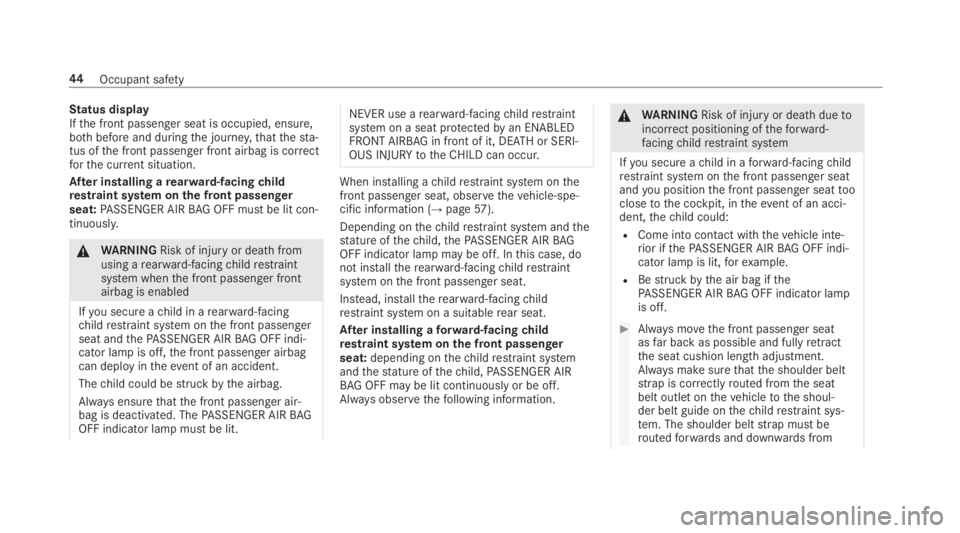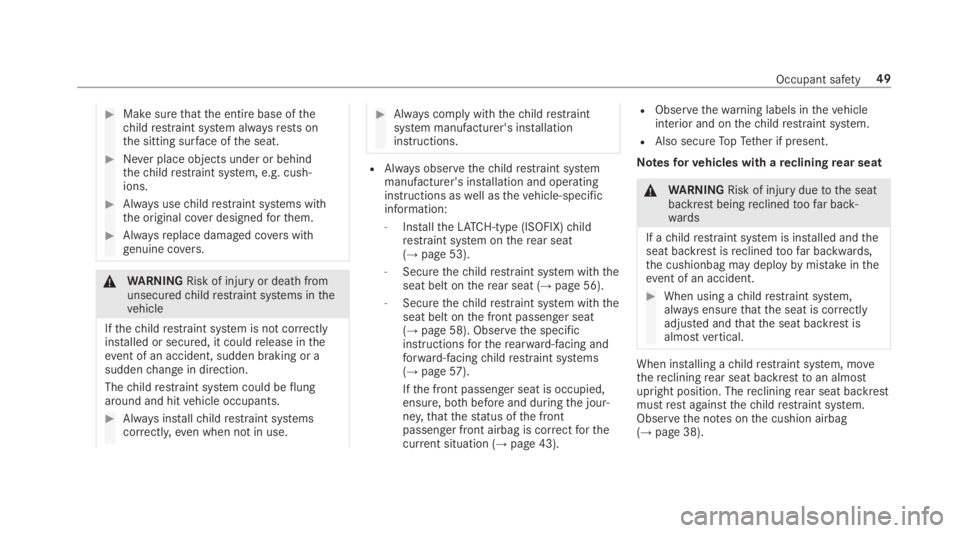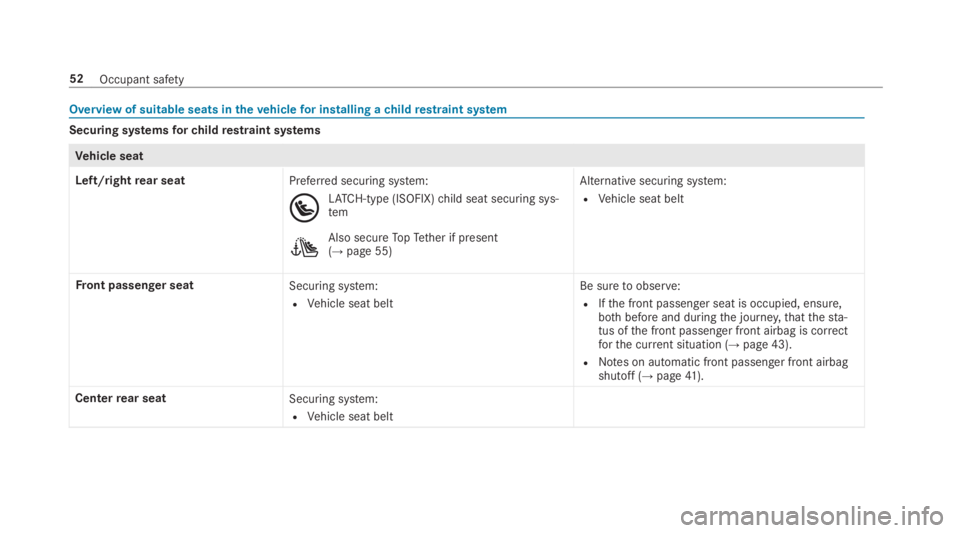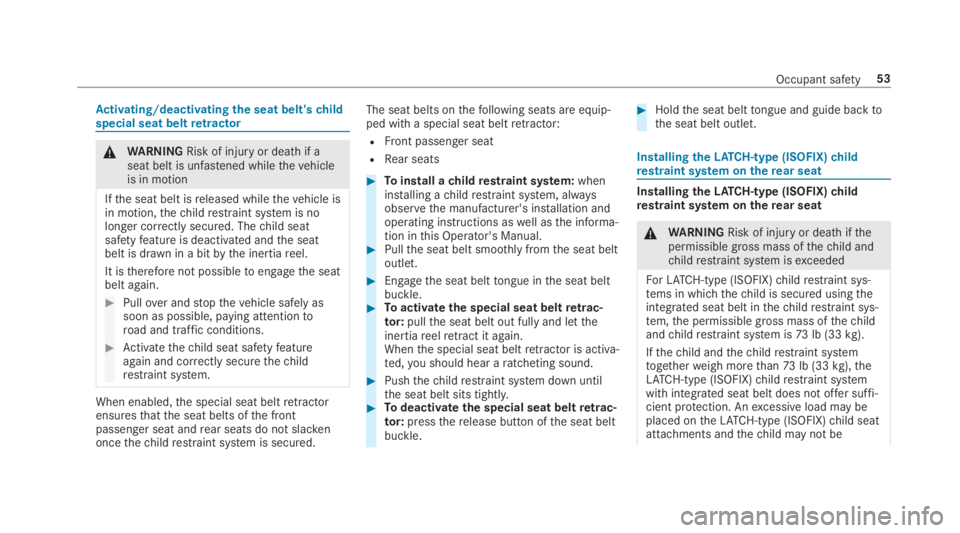2019 MERCEDES-BENZ S CLASS ECU
[x] Cancel search: ECUPage 42 of 578

#Always make surethatthere are noobjects betweenthe air bag andthevehicle occupant.
Toavoidtherisksresulting fromthe deploymentof an airbag, eachvehicle occupant mustobservethefollowing information:
RBeforestartingyour journey,adjustyour seatcorrectly;the driver's seat and front-passenger seat should be moved asfar backas possible.
When doing so, always observethe informa‐tion onthe correct driver's seat position(→page92).
ROnly holdthesteering wheelbythesteeringwheelrim. This allowsthe airbagtobe fullydeployed.
RAlways lean againstthe seat backrest whenthevehicle is in motion. Do not leanforwardsor againstthe door or side window.You mayotherwise be inthe deployment area oftheairbags.
RAlwayskeepyourfeetonthefloor. Do notputyourfeetonthe cockpit,forexample.
Yourfeetmayotherwise be inthe deploy‐ment area ofthe airbag.
RIfchildren are traveling inthevehicle,observethe additional notes (→page 48).
RAlwaysstowand secure objects correctly.
Objects inthevehicle interior may prevent anairbag from functioning correctly. Eachvehicleoccupant must always make sure ofthefollow‐ing:
RThere are no people, animals or objectsbetweenthevehicle occupants and an air‐bag.
RThere are no objects betweenthe seat, doorand door pillar (B-pillar).
RThere are no hard objects, e.g. coat hangers,hanging onthe grab handles or coat hooks.
RThere are no accessory parts, such as PNDs(PersonalNavigation Devices), mobilephones or cup holders attachedtothevehi‐cle withinthe deployment area of an airbag,e.g. onthe cockpit, on doors, side windowsor side paneling.
In addition, no connecting cable,tensioningstrap orretainingstrap may beroutedthrough or attached inthe deployment areaof an airbag. Always observethe accessorymanufacturer's installation instructions, inparticularthe information on suitable placesfor installation.
RThere are no heavy, sharp-edged or fragileobjects inthe pockets ofyour clothing.Storesuch objects in a suitable place.
Limited protection from airbags
&WARNINGRisk of injuryduetomodifi‐cationstothe airbag cover
Ifyou modifythe cover of an airbag or affixobjects such asstickerstoit,the airbag mayno longer function correctly.
#Never modifythe cover of an airbag anddo not affix objectstoit.
The installation location of an airbag is identifiedbythe AIRBAGsymbol (→page 38).
40Occupant safety
Page 46 of 578

Status displayIfthe front passenger seat is occupied, ensure,bothbefore and duringthe journey,thatthesta‐tus ofthe front passenger front airbag is correctforthe current situation.
After installing arearward-facingchildrestraint system onthe front passengerseat:PASSENGER AIRBAG OFF must be lit con‐tinuously.
&WARNINGRisk of injuryor death fromusing arearward-facingchildrestraintsystem whenthe front passenger frontairbag is enabled
Ifyou secure achild in arearward-facingchildrestraint system onthe front passengerseat andthePASSENGER AIRBAG OFF indi‐cator lamp is off,the front passenger airbagcan deploy intheevent of an accident.
Thechild could bestruckbythe airbag.
Always ensurethatthe front passenger air‐bag is deactivated. ThePASSENGER AIRBAGOFF indicator lamp must be lit.
NEVER use arearward-facingchildrestraintsystem on a seat protectedbyan ENABLEDFRONT AIRBAGin front of it, DEATH or SERI‐OUS INJURYtotheCHILD can occur.
When installing achildrestraint system onthefront passenger seat, observethevehicle-spe‐cific information (→page57).
Depending onthechildrestraint system andthestature ofthechild,thePASSENGER AIRBAGOFF indicator lamp may be off. Inthis case, donot installtherearward-facingchildrestraintsystem onthe front passenger seat.
Instead, installtherearward-facingchildrestraint system on a suitablerear seat.
After installing aforward-facingchildrestraint system onthe front passengerseat:depending onthechildrestraint systemandthestature ofthechild,PASSENGER AIRBAG OFF may be lit continuously or be off.Always observethefollowing information.
&WARNINGRisk of injuryor death duetoincorrect positioning oftheforward-facingchildrestraint system
Ifyou secure achild in aforward-facingchildrestraint system onthe front passenger seatandyou positionthe front passenger seattooclosetothe cockpit, intheevent of an acci‐dent,thechild could:
RCome into contact with thevehicle inte‐rior ifthePASSENGER AIRBAG OFF indi‐cator lamp is lit,forexample.
RBestruckbythe air bag ifthePASSENGER AIRBAG OFF indicator lampis off.
#Always movethe front passenger seatasfar back as possible and fullyretractthe seat cushion length adjustment.Always make surethatthe shoulder beltstrap is correctlyrouted fromthe seatbelt outlet onthevehicletothe shoul‐der belt guide onthechildrestraint sys‐tem. The shoulder beltstrap must beroutedforwards and downwards from
44Occupant safety
Page 49 of 578

If an accident did not occur,the pre-emptivemeasuresthatweretaken arereversed.
System limitations
The system will not initiate any action inthefol‐lowing situations:
Rwhen backing up
The system will not initiate any braking applica‐tion inthefollowing situations:
Rwhilst driving
or
Rwhen entering orexiting a parking spacewhile usingActiveParking Assist
Safely transportingchildren inthevehicle
Always observewhenchildren are travelinginthevehicle
%Alsostrictly observethe safety notesforthespecific situation. Inthiswayyou canrecog‐nize potentialrisks andavoid dangers ifchil‐dren are traveling inthevehicle(→page 48).
Be diligentBear in mindthat neglectingtosecure achild inthechildrestraint system may haveserious con‐sequences. Always be diligent in securing achildcarefully beforeeveryjourney.
Toimproveprotectionforchildrenyoungerthan12years old or under 5ft(1.50 m) in height,Mercedes-Benzrecommendsyou observethefollowing information:
RAlways securethechild in achildrestraintsystem suitableforthis Mercedes-Benzvehi‐cle.
RThechildrestraint system must be appropri‐atetothe age,weight and size ofthechild.
RThevehicle seat must be suitablefor instal‐ling achildrestraint system.
Accidentstatistics showthatchildren secured intherear seats aregenerally saferthanchildrensecured inthe front seats.Forthisreason,Mercedes-Benzstrongly advisesthatyou installachildrestraint system on arear seat.
Genericterm"childrestraint system"
Thegenerictermchildrestraint system is usedinthis Operator's Manual. Achildrestraint sys‐tem is,forexample:
Ra baby car seat
Rarearward-facingchild seat
Raforward-facingchild seat
Rachild booster seat with a backrest and seatbelt guide
Mercedes-Benzrecommends using achildbooster seat with a backrest.
Thechildrestraint system must be appropriatetothe age,weight and size ofthechild.
Observing lawsand legalrequirementsAlways observethe legalrequirements whenusing achildrestraint system inthevehicle.
Occupant safety47
Page 50 of 578

Observingstandardsforchildrestraint sys‐tems
Allchildrestraint systems must meetthefollow‐ingstandards:
RU.S.Federal MotorVehicle SafetyStandards213 and 225
RCanadian MotorVehicle SafetyStandards213 and210.2
Confirmationthatthechildrestraint systemcomplies withthestandards can befound on aninstruction label onthechildrestraint system.This confirmation can also befound inthe instal‐lation instructionsthat are included withthechildrestraint system.
Detectingrisks,avoiding danger
Securing systemsforchildrestraint systemsinthevehicle
Only usethefollowing securing systemsforchildrestraint systems:
RtheLATCH-type (ISOFIX) mounting brackets
Rthevehicle's seat belt system
RtheTopTether anchorages
Installing aLATCH-type (ISOFIX)childrestraintsystem is preferred.
Simply attachingtothe securingrings onthevehicle canreducetherisk of installingthechildrestraint system incorrectly.
When securing achild withthe integrated seatbelt oftheLATCH-type (ISOFIX)childrestraintsystem, always comply withthe permissiblegrossweightforthechild andchildrestraint sys‐tem (→page 53).
A booster seat may be necessarytoachieveproper seat belt positioningforchildrenover40 lbs (18kg) inweight or untiltheyreach aheight where athree-point seat belt can beinstalled properlywithout a booster seat.
Mercedes-Benzrecommends a suitablechildbooster seat with a backrest and seat belt guide.
Advantage of arearward-facingchildrestraint systemIt is preferabletotransporta baby or a smallchild in a suitablerearward-facingchildrestraintsystem. Inthis case,thechild sits inthe oppo‐
site directiontothe direction of travel andfacesbackwards.
Babies and smallchildren havecomparativelyweak neck muscles inrelationtothe size andweight oftheir head. Therisk of injurytothe cer‐vical spine during an accident can bereduced inarearward-facingchildrestraint system.
Always secure achildrestraint system cor‐rectly
&WARNINGRisk of injuryor death causedbyincorrect installation ofthechildrestraint system
Ifthechildrestraint system is incorrectlyinstalled on a suitable seating position, itcannot performits intended protective func‐tion.
Thechild cannot berestrained intheevent ofan accident, heavy braking or a suddenchange of direction.
#Always comply withthe manufacturer'sinstallation instructionsforthechildrestraint system and its correct use.
48Occupant safety
Page 51 of 578

#Make surethatthe entire base ofthechildrestraint system alwaysrests onthe sitting surface ofthe seat.
#Never place objects under or behindthechildrestraint system, e.g. cush‐ions.
#Always usechildrestraint systems withthe original cover designedforthem.
#Alwaysreplace damaged coverswithgenuine covers.
&WARNINGRisk of injuryor death fromunsecuredchildrestraint systems inthevehicle
Ifthechildrestraint system is not correctlyinstalled or secured, it couldrelease intheevent of an accident, sudden braking or asuddenchange in direction.
Thechildrestraint system could beflungaround and hitvehicle occupants.
#Always installchildrestraint systemscorrectly,even when not in use.
#Always comply withthechildrestraintsystem manufacturer's installationinstructions.
RAlways observethechildrestraint systemmanufacturer's installation and operatinginstructions aswell asthevehicle-specificinformation:
-InstalltheLATCH-type (ISOFIX)childrestraint system ontherear seat(→page 53).
-Securethechildrestraint system withtheseat belt ontherear seat (→page 56).
-Securethechildrestraint system withtheseat belt onthe front passenger seat(→page 58). Observethe specificinstructionsfortherearward-facing andforward-facingchildrestraint systems(→page57).
Ifthe front passenger seat is occupied,ensure, bothbefore and duringthe jour‐ney,thatthestatus ofthe frontpassenger front airbag is correctforthecurrent situation (→page43).
RObservethewarning labels inthevehicleinterior and onthechildrestraint system.
RAlso secureTopTether if present.
Notesforvehicles with arecliningrear seat
&WARNINGRisk of injuryduetothe seatbackrest beingreclinedtoofar back‐wards
If achildrestraint system is installed andtheseat backrest isreclinedtoofar backwards,the cushionbag may deploybymistakeintheevent of an accident.
#When using achildrestraint system,always ensurethatthe seat is correctlyadjusted andthatthe seat backrest isalmostvertical.
When installing achildrestraint system, movetherecliningrear seat backresttoan almostupright position. Therecliningrear seat backrestmustrestagainstthechildrestraint system.Observethe notes onthe cushion airbag(→page 38).
Occupant safety49
Page 52 of 578

Ifyou install achildrestraint system ontherecliningrear seat, be suretoobservethechildrestraint system manufacturer's installationinstructions.
Do not alterthechildrestraint system
&WARNINGRisk of injuryduetomodifi‐cationstothechildrestraint system
Thechildrestraint system may no longerfunction as it is supposedtoifyou makemodifications or attach objectstoit, e.g.toysor unsuitable accessories. This poses anincreasedrisk of injury!
Never modifythechildrestraint system. Onlyattach accessories whichthe manufacturerofthechildrestraint system has authorizedespeciallyforthischildrestraint system.
Only usechildrestraint systems which are inproperworking condition
&WARNINGRisk of injuryor death causedbythe use of damagedchildrestraintsystems
Childrestraint systems ortheirretaining sys‐temsthat havebeen subjectedtoa load inan accident maythen not be abletoperformtheir intended protective function.
Thechild cannot berestrained intheevent ofan accident, heavy braking or a suddenchange of direction.
#Alwaysreplacechildrestraint systemsimmediatelythat havebeen damaged orinvolved in an accident.
#Havethe securing systemsforthechildrestraint systemschecked at aqualifiedspecialistworkshop before installing achildrestraint system again.
Avoiding direct sunlight
&WARNINGRisk of burns whenthechildseat isexposedtodirect sunlight
Ifthechildrestraint system isexposedtodirect sunlight or heat, parts could heat up.
Children could suffer burns fromthese parts,particularly on metallic parts ofthechildrestraint system.
#Always make surethatthechildrestraint system is notexposedtodirect sunlight.
#Protect it with a blanket,forexample.
#Ifthechildrestraint system has beenexposedtodirect sunlight, allow ittocool before securing achild into it.
#Never leavechildren unattended inthevehicle.
50Occupant safety
Page 54 of 578

Overview of suitable seats inthevehiclefor installing achildrestraint system
Securing systemsforchildrestraint systems
Vehicle seat
Left/rightrear seatPreferred securing system:
LATCH-type (ISOFIX)child seat securing sys‐tem
Also secureTopTether if present(→page 55)
Alternative securing system:
RVehicle seat belt
Front passenger seatSecuring system:
RVehicle seat belt
Be suretoobserve:
RIfthe front passenger seat is occupied, ensure,bothbefore and duringthe journey,thatthesta‐tus ofthe front passenger front airbag is correctforthe current situation (→page43).
RNotes on automatic front passenger front airbagshutoff (→page41).
Centerrear seatSecuring system:
RVehicle seat belt
52Occupant safety
Page 55 of 578

Activating/deactivating the seat belt'schildspecial seat beltretractor
&WARNINGRisk of injuryor death if aseat belt is unfastened whilethevehicleis in motion
Ifthe seat belt isreleased whilethevehicle isin motion,thechildrestraint system is nolonger correctly secured. Thechild seatsafetyfeature is deactivated andthe seatbelt is drawn in a bitbythe inertiareel.
It istherefore not possibletoengagethe seatbelt again.
#Pullover andstopthevehicle safely assoon as possible, paying attentiontoroad and traffic conditions.
#Activatethechild seat safetyfeatureagain and correctly securethechildrestraint system.
When enabled,the special seat beltretractorensuresthatthe seat belts ofthe frontpassenger seat andrear seats do not slackenoncethechildrestraint system is secured.
The seat belts onthefollowing seats are equip‐ped with a special seat beltretractor:
RFront passenger seat
RRear seats
#Toinstall achildrestraint system:wheninstalling achildrestraint system, alwaysobservethe manufacturer's installation andoperating instructions aswell asthe informa‐tion inthis Operator's Manual.#Pullthe seat belt smoothly fromthe seat beltoutlet.
#Engagethe seat belttongue inthe seat beltbuckle.#Toactivatethe special seat beltretrac‐tor:pullthe seat belt out fully and lettheinertiareelretract it again.Whenthe special seat beltretractor is activa‐ted,you should hear aratcheting sound.
#Pushthechildrestraint system down untilthe seat belt sits tightly.#Todeactivate the special seat beltretrac‐tor:presstherelease button ofthe seat beltbuckle.
#Holdthe seat belttongue and guide backtothe seat belt outlet.
InstallingtheLATCH-type (ISOFIX)childrestraint system ontherear seat
InstallingtheLATCH-type (ISOFIX)childrestraint system ontherear seat
&WARNINGRisk of injuryor death ifthepermissible gross mass ofthechild andchildrestraint system isexceeded
ForLATCH-type (ISOFIX)childrestraint sys‐tems in whichthechild is secured usingtheintegrated seat belt inthechildrestraint sys‐tem,the permissible gross mass ofthechildandchildrestraint system is73lb (33kg).
Ifthechild andthechildrestraint systemtogetherweigh morethan73lb (33kg),theLATCH-type (ISOFIX)childrestraint systemwith integrated seat belt does not offer suffi‐cient protection. Anexcessive load may beplaced ontheLATCH-type (ISOFIX)child seatattachments andthechild may not be
Occupant safety53